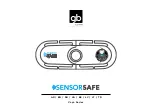
4-36
E l o E n t u i t i v e T o u c h m o n i t o r
Disassembling the Display
Disassemble the monitor on a large, well-lit work surface. Leave space to set
aside major monitor components. Group screws and other hardware in small
containers or in specific areas on the work surface as you remove them, in
relation to the part of the monitor where you are working. If you complete the
installation process in one session (which may require several hours for your
first efforts), it is unlikely that you will have trouble reassembling the monitor.
Most monitor manufacturers connect the major components with detachable
cables that have labeled and keyed connectors; these cables are of lengths that
will usually connect to only one place. Also, screws are identifiable by type and
size, and usually will not fit in the wrong place. The most difficult problem with
missing or wrong hardware or connections will be with single ground cables
that attach to obscure ground points on the metal chassis. When in doubt, make
notes of the connection points.
Removing the Back Case
Figure 4.1 on page 4-33, shows the typical construction of a 14-inch monitor.
Disassembly usually starts with removal of the back case. For assistance with
disassembly, consult your particular manufacturer's service manual. Carefully
lay the monitor on its face on the padded work surface and remove the screws
that attach the back case to the bezel or frame.
While removing the back case, note the clearance between the inside rear
surface of the case and a small circuit board plugged into a socket on the end of
the CRT. If there is not enough clearance to move the CRT and this circuit
board about 3/8-inch (9 mm) toward the rear of the case, you may be unable to
successfully install a touchscreen on the monitor and completely reinstall the
back case. Contact Elo Technical Support for possible alternatives.
After the back case is removed, the CRT is substantially exposed. Use extreme
care when working around the CRT.
WARNING:
Impact or force against the neck of the CRT, or the pins at the end where the small
circuit board is attached, could crack the tube, resulting in loss of vacuum or
implosion of the tube. Either result destroys the CRT. Implosion (collapse of the
glass inward, caused by the high vacuum inside the tube), followed by the
rebound of many glass pieces outward, is potentially lethal to anyone in the imme-
diate area. Handle the CRT carefully, keep tools away from the CRT, and wear pro-
tective clothing including eye protection. See Safety Information, page 32.
Содержание AccuTouch 821615-000
Страница 3: ...4...
Страница 5: ...12...
Страница 9: ...8...
Страница 15: ...1 16 E l o E n t u i t i v e T o u c h m o n i t o r...
Страница 55: ...4 60 E l o E n t u i t i v e T o u c h m o n i t o r...
Страница 75: ...A 80 I n t e l l i T o u c h S e c u r e T o u c h G u i d e...
Страница 78: ...B 83 2210 Serial Controller Figure B 2 E271 2210 Serial Controller...
Страница 83: ...B 88 I n t e l l i T o u c h S e c u r e T o u c h G u i d e...
Страница 92: ...C 97...
Страница 93: ...C 98 I n t e l l i T o u c h S e c u r e T o u c h G u i d e...
















































